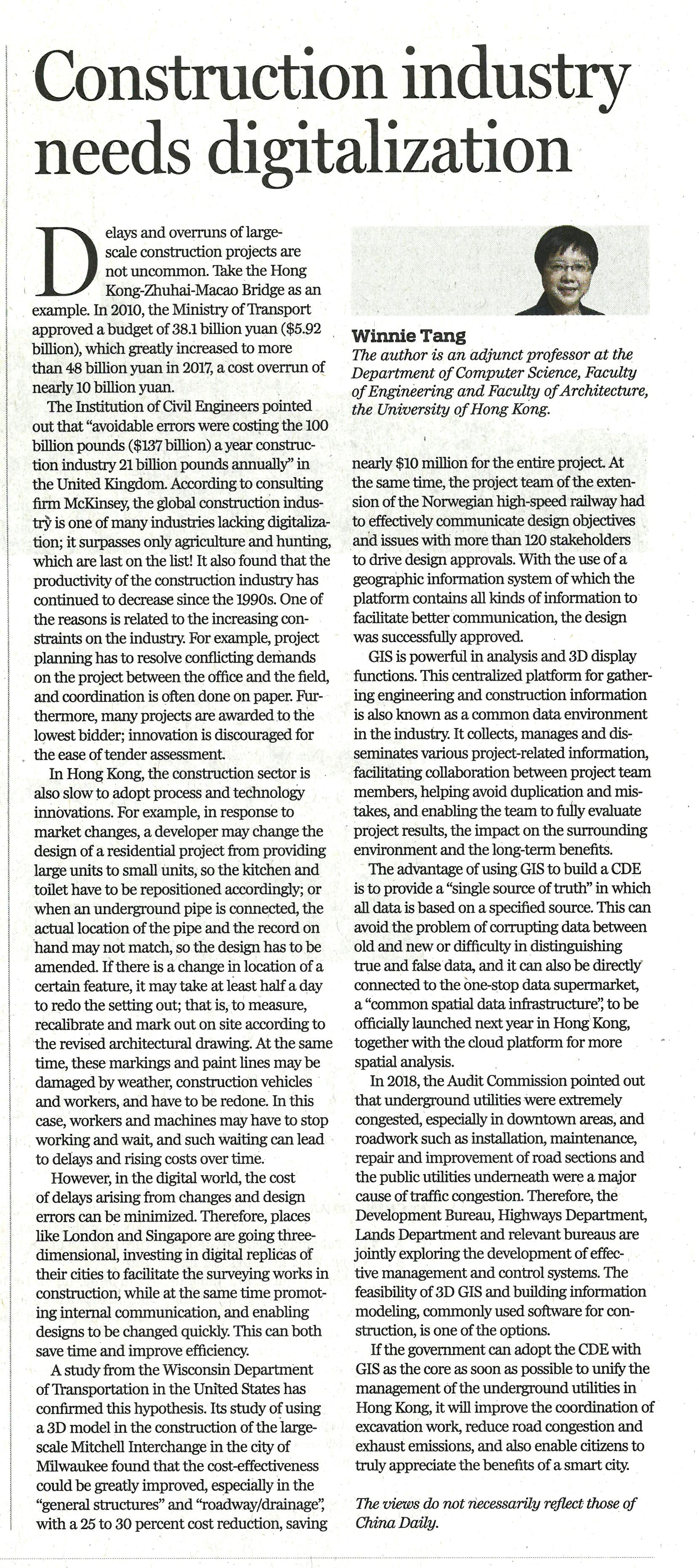網上版請按此

Construction industry needs digitalization
Delays and overruns of large-scale construction projects are not uncommon. Take the Hong Kong-Zhuhai-Macao Bridge as an example. In 2010, the Ministry of Transport approved a budget of 38.1 billion yuan ($5.92 billion), which greatly increased to more than 48 billion yuan in 2017, a cost overrun of nearly 10 billion yuan.
The Institution of Civil Engineers pointed out that "avoidable errors were costing the 100 billion pounds ($137 billion) a year construction industry 21 billion pounds annually" in the United Kingdom. According to consulting firm McKinsey, the global construction industry is one of many industries lacking digitalization; it surpasses only agriculture and hunting, which are last on the list! It also found that the productivity of the construction industry has continued to decrease since the 1990s. One of the reasons is related to the increasing constraints on the industry. For example, project planning has to resolve conflicting demands on the project between the office and the field, and coordination is often done on paper. Furthermore, many projects are awarded to the lowest bidder; innovation is discouraged for the ease of tender assessment.
In Hong Kong, the construction sector is also slow to adopt process and technology innovations. For example, in response to market changes, a developer may change the design of a residential project from providing large units to small units, so the kitchen and toilet have to be repositioned accordingly; or when an underground pipe is connected, the actual location of the pipe and the record on hand may not match, so the design has to be amended. If there is a change in location of a certain feature, it may take at least half a day to redo the setting out; that is, to measure, recalibrate and mark out on site according to the revised architectural drawing. At the same time, these markings and paint lines may be damaged by weather, construction vehicles and workers, and have to be redone. In this case, workers and machines may have to stop working and wait, and such waiting can lead to delays and rising costs over time.
However, in the digital world, the cost of delays arising from changes and design errors can be minimized. Therefore, places like London and Singapore are going three-dimensional, investing in digital replicas of their cities to facilitate the surveying works in construction, while at the same time promoting internal communication, and enabling designs to be changed quickly. This can both save time and improve efficiency.
A study from the Wisconsin Department of Transportation in the United States has confirmed this hypothesis. Its study of using a 3D model in the construction of the large-scale Mitchell Interchange in the city of Milwaukee found that the cost-effectiveness could be greatly improved, especially in the "general structures" and "roadway/drainage", with a 25 to 30 percent cost reduction, saving nearly $10 million for the entire project. At the same time, the project team of the extension of the Norwegian high-speed railway had to effectively communicate design objectives and issues with more than 120 stakeholders to drive design approvals. With the use of a geographic information system of which the platform contains all kinds of information to facilitate better communication, the design was successfully approved.
GIS is powerful in analysis and 3D display functions. This centralized platform for gathering engineering and construction information is also known as a common data environment in the industry. It collects, manages and disseminates various project-related information, facilitating collaboration between project team members, helping avoid duplication and mistakes, and enabling the team to fully evaluate project results, the impact on the surrounding environment and the long-term benefits.
The advantage of using GIS to build a CDE is to provide a "single source of truth" in which all data is based on a specified source. This can avoid the problem of corrupting data between old and new or difficulty in distinguishing true and false data, and it can also be directly connected to the one-stop data supermarket, a "common spatial data infrastructure", to be officially launched next year in Hong Kong, together with the cloud platform for more spatial analysis.
In 2018, the Audit Commission pointed out that underground utilities were extremely congested, especially in downtown areas, and roadwork such as installation, maintenance, repair and improvement of road sections and the public utilities underneath were a major cause of traffic congestion. Therefore, the Development Bureau, Highways Department, Lands Department and relevant bureaus are jointly exploring the development of effective management and control systems. The feasibility of 3D GIS and building information modeling, commonly used software for construction, is one of the options.
If the government can adopt the CDE with GIS as the core as soon as possible to unify the management of the underground utilities in Hong Kong, it will improve the coordination of excavation work, reduce road congestion and exhaust emissions, and also enable citizens to truly appreciate the benefits of a smart city.
Dr. Winnie Tang
Adjunct Professor, Department of Computer Science, Faculty of Engineering; Department of Geography, Faculty of Social Sciences; and Faculty of Architecture, The University of Hong Kong